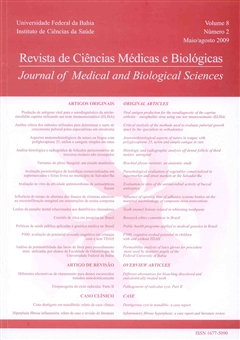Evaluation in vitro of the antimicrobial activity of buccal antiseptics
DOI:
https://doi.org/10.9771/cmbio.v8i2.4065Keywords:
Buccal antiseptics- Antimicrobial activity - Dental biofilm - Diffusion in agarAbstract
This work aims at evaluating the antimicrobial activity of buccal antiseptics on Streptococcus mutans ATCC 25175, Pseudomonas aeruginosa ATCC 115442, Enterococcus faecalis, Staphylococcus aureus ATCC 6538 and on bacteria obtained from saliva samples of ten individuals. Mouthrinses containing chlorhexidine gluconate at 0.12%, chlorhexidine gluconate at 0,2%, chloride of cetilpyridine with and without fluorine, thymol, tricosane with fluorine, mallow extract with fluorine and xylital and hydrogen peroxide have been analysed. Diffusion in agar, method of the plate with orifice and with incubation at 37º C in aerobiosis and microaerophilia, was the technique utilized. After incubation, the presence or absence of the halo of growth inhibition around the orifices was observed. The halo formation showed antimicrobial activity. In the mouthrinses containing thymol, and fluorine associated with xylitol, no activity on the used bacteria was evidenced. The other mouthrinses presented efficacy on the bacteria, with the exception of those containing chloride of cetilpyridine that did not present activity on Pseudomona aeruginosa, and of the mouthrinse with mallow associated with fluorine and xylitol, without activity on P. aeruginosa, S. mutans and saliva bacteria. The mouthrinses containing triclosane with fluorine, hydrogen peroxide and chlorhexidine were the most effective, in accordance with the diameter of the formed inhibition halos and the used methodology. The obtained results proved that antiseptic substances may become a complementary option of controlling the dental biofilm and the buccal infections, in addition to the methods already recommended and of proven effect.Downloads
Download data is not yet available.
Downloads
Published
2009-06-02
How to Cite
Moreira, A. C. A., Pereira, M. H. Q., Porto, M. R., Rocha, L. A. P. da, Nascimento, B. C., & Andrade, P. M. (2009). Evaluation in vitro of the antimicrobial activity of buccal antiseptics. Journal of Medical and Biological Sciences, 8(2), 153–161. https://doi.org/10.9771/cmbio.v8i2.4065
Issue
Section
ORIGINAL ARTICLES
License
The Journal of Medical and Biological Sciences reserves all copyrights of published works, including translations, allowing, however, their subsequent reproduction as transcription, with proper citation of source, through the Creative Commons license. The periodical has free and free access.


